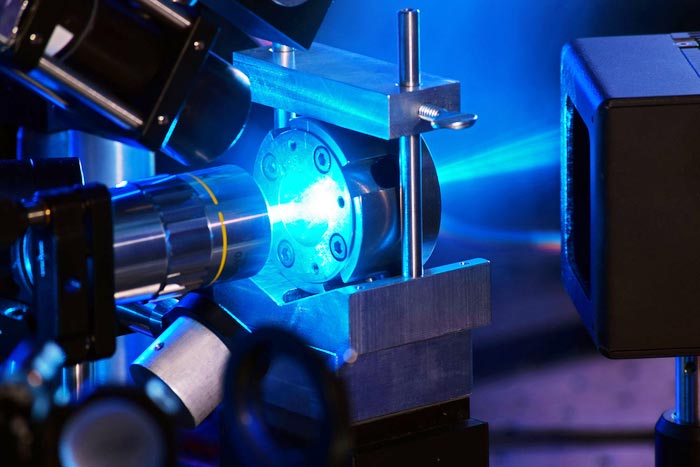UNLV researchers discover new form of ice

UNLV physicists pioneered a new laser-heating technique in a diamond anvil cell (pictured here) as part of their discovery of a new form of ice.
Credit: Chris Higgins
Findings could have implications for our understanding of distant, water-rich planets.
UNLV researchers have discovered a new form of ice, redefining the properties of water at high pressures.
Solid water, or ice, is like many other materials in that it can form different solid materials based on variable temperature and pressure conditions, like carbon forming diamond or graphite. However, water is exceptional in this aspect as there are at least 20 solid forms of ice known to us.
A team of scientists working in UNLV’s Nevada Extreme Conditions Lab pioneered a new method for measuring the properties of water under high pressure. The water sample was first squeezed between the tips of two opposite-facing diamonds—freezing into several jumbled ice crystals. The ice was then subjected to a laser-heating technique that temporarily melted it before it quickly re-formed into a powder-like collection of tiny crystals.
By incrementally raising the pressure, and periodically blasting it with the laser beam, the team observed the water ice make the transition from a known cubic phase, Ice-VII, to the newly discovered intermediate, and tetragonal, phase, Ice-VIIt, before settling into another known phase, Ice-X.
Zach Grande, a UNLV Ph.D. student, led the work which also demonstrated that the transition to Ice-X, when water stiffens aggressively, occurs at much lower pressures than previously thought.
While it’s unlikely we’ll find this new phase of ice anywhere on the surface of Earth, it is likely a common ingredient within the mantle of Earth as well as in large moons and water-rich planets outside of our solar system.
The team’s findings were reported in the March 17 issue of the journal Physical Review B.
Takeaways
The research team had been working to understand the behavior of high-pressure water that may be present in the interior of distant planets.
To do so, Grande and UNLV physicist Ashkan Salamat placed a sample of water between the tips of two round-cut diamonds known as diamond anvil cells, a standard feature in the field of high pressure physics. Applying a little bit of force to the diamonds enabled the researchers to recreate pressures as high as those found at the center of the Earth.
By squeezing the water sample between these diamonds, scientists drove the oxygen and hydrogen atoms into a variety of different arrangements, including the newly discovered arrangement, Ice-VIIt.
Not only did the first-of-its-kind laser-heating technique allow scientists to observe a new phase of water ice, but the team also found that the transition to Ice-X occurred at pressures nearly three times lower than previously thought — at 300,000 atmospheres instead of 1 million. This transition has been a highly debated topic in the community for several decades.
“Zach’s work has demonstrated that this transformation to an ionic state occurs at much, much lower pressures than ever thought before,” Salamat said. “It’s the missing piece, and the most precise measurements ever on water at these conditions.”
The work also recalibrates our understanding of the composition of exoplanets, Salamat added. Researchers hypothesize that the Ice-VIIt phase of ice could exist in abundance in the crust and upper mantle of expected water-rich planets outside of our solar system, meaning they could have conditions habitable for life.
Publication details
“Pressure driven symmetry transitions in dense H2O ice,” was published March 17 in the journal Physical Review B.
Collaborators at the Lawrence Livermore National Laboratory used a large supercomputer to simulate the bond rearrangement—predicting that the phase transitions should happen precisely where they were measured by the experiments.
Additional collaborators include UNLV physicists Jason Steffen and John Boisvert, UNLV mineralogist Oliver Tschauner, and scientists from the Argonne National Laboratory and the University of Arizona.
Journal: Physical Review B
DOI: 10.1103/PhysRevB.105.104109
Method of Research: Observational study
Subject of Research: Not applicable
Article Title: Pressure-driven symmetry transitions in dense H2O ice
Article Publication Date: 17-Mar-2022
Media Contact
Natalie Bruzda
University of Nevada, Las Vegas
natalie.bruzda@unlv.edu
Office: 702-895-5132
All latest news from the category: Physics and Astronomy
This area deals with the fundamental laws and building blocks of nature and how they interact, the properties and the behavior of matter, and research into space and time and their structures.
innovations-report provides in-depth reports and articles on subjects such as astrophysics, laser technologies, nuclear, quantum, particle and solid-state physics, nanotechnologies, planetary research and findings (Mars, Venus) and developments related to the Hubble Telescope.
Newest articles

Pinpointing hydrogen isotopes in titanium hydride nanofilms
Although it is the smallest and lightest atom, hydrogen can have a big impact by infiltrating other materials and affecting their properties, such as superconductivity and metal-insulator-transitions. Now, researchers from…

A new way of entangling light and sound
For a wide variety of emerging quantum technologies, such as secure quantum communications and quantum computing, quantum entanglement is a prerequisite. Scientists at the Max-Planck-Institute for the Science of Light…

Telescope for NASA’s Roman Mission complete, delivered to Goddard
NASA’s Nancy Grace Roman Space Telescope is one giant step closer to unlocking the mysteries of the universe. The mission has now received its final major delivery: the Optical Telescope…



